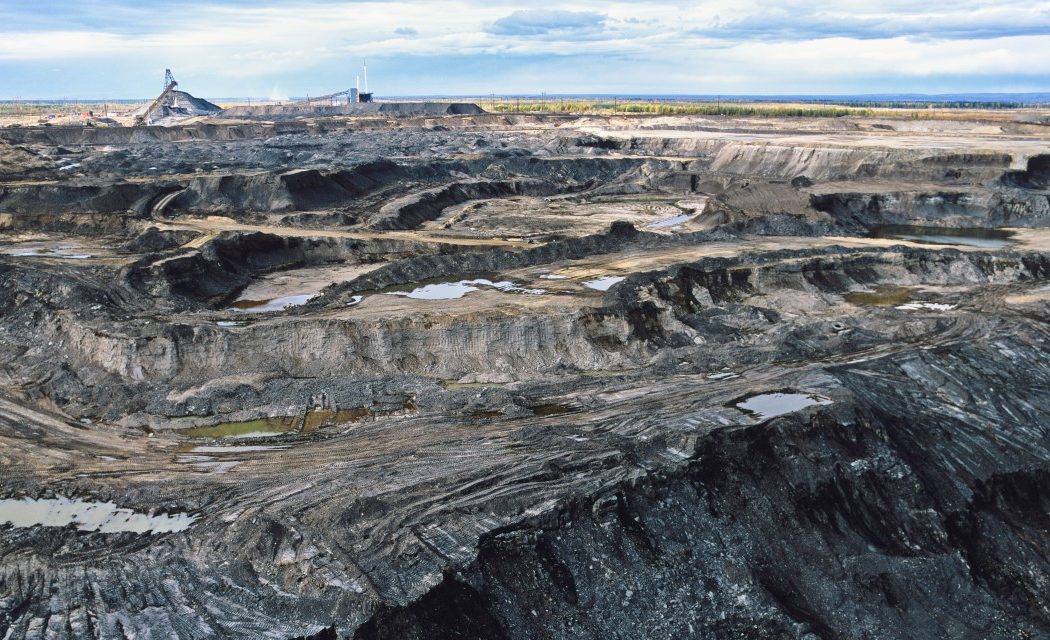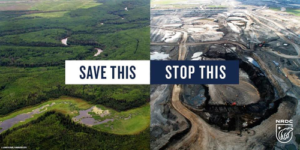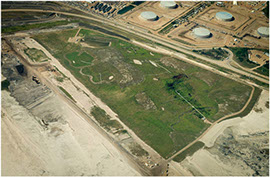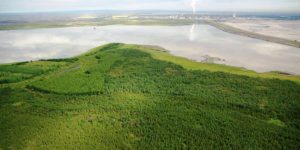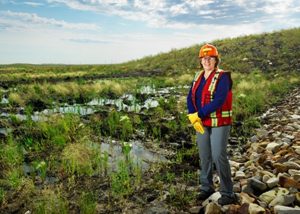Out of the 650 square kilometres across northern Alberta, Canada actively used for tarsands mines, tailings ponds and other facilities in 2015, about 60 square kilometres had been permanently reclaimed, meaning restoration work was done but not certified as complete by the province.
“The major challenge is the complexity of what you’re trying to do,” said Jenna Dunlop, director of the land environmental priority area for Canada’s Oil Sands Innovation Alliance (COSIA), an industry research organization. “It’s the reverse engineering of a system when you don’t actually have a complete understanding of how things work together, putting back a large ecosystem and expecting not only to have that sustainable and work as an integrated system, but you’re going to create the same functionality.”
The path to reclaiming land torn up for a mine starts during construction, when the soil and organic matter, referred to as overburden, are set aside in storage.
Reclamation can take decades. In 2010, Suncor became the first company to reclaim a former tailings pond to the point where the surface can support traffic, complete with a forest, streams and a marsh wetland.
The company built the 220-hectare Wapisiw Lookout by dumping 65,000 truckloads of soil to create a layer 50 centimetres deep. It was then planted with more than 600,000 trees and shrubs.
But it will take almost 20 years to find out if the site will successfully qualify for official certification from the province, which is slow to receive, due in part to the fact that ecological restoration standards are still evolving.
A 2015 book by Alberta ecologist Kevin Timoney argued that rebuilding wetlands in the oilsands region was failing, with many sites contaminated, becoming risky to wildlife and creating a damaged landscape.
Let’s acknowledge up front that Alberta, Canada tar sands operations are probably the most irresponsible and destructive recently-developed fossil fuel source on the planet. I (Storm) mentioned this in my second book, Rewealth (McGraw-Hill, 2008).
I specify “recently developed” to separate it from older environmental, social, and policial catastrophe’s like the oil industry operations in Nigeria‘s Niger Delta, which looks like it’s about to explode into violence once again.
To avoid confusion (should you be Googling the subject), oil companies prefer to call the Alberta resources “oilsands“, to downplay the filthy, energy-intensive nature of extracting oil from them.
You can observe the choice of terminology to instantly determine whether someone is an environmentalist, or whether they are on the side of the fossil fuel industry (or are terrified of annoying the industry, as is common among public leaders in fossil fuel-dependent economies everywhere around the world).
Tar sands are a mixture of mostly sand, clay, water, and a thick, molasses-like substance called bitumen. Extracting bitumen from tar sands—and refining it into products like gasoline—is significantly costlier and more difficult than extracting and refining liquid oil.
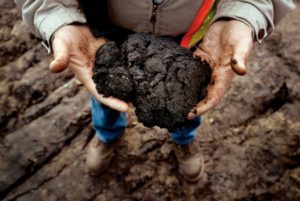
Bitumen. Photo credit: Desmog Canada.
Common extraction methods include surface mining—where the extraction site is excavated—and “in-situ” mining, where steam is used to liquefy bitumen deep underground. On a lifetime basis, a gallon of gasoline made from tar sands produces about 15% more carbon dioxide emissions than one made from conventional oil.
The average “energy returned on investment,” or EROI, for conventional oil is roughly 25:1. In other words, 25 units of oil-based energy are obtained for every one unit of other energy that is invested to extract it.
But tar sands oil is in a category all its own. Tar sands retrieved by surface mining has an EROI of only about 5:1. Tar sands retrieved from deeper beneath the earth, through steam injection, fares even worse, with a maximum average ratio of just 2.9 to 1. That means one unit of natural gas is needed to create less than three units of oil-based energy. “They have to use a lot of natural gas to upgrade this heavy, sticky, gooky almost tar-like stuff to make it fluid enough to use,” said Charles Hall, a professor at the State University of New York’s College of Environmental Science and Forestry.
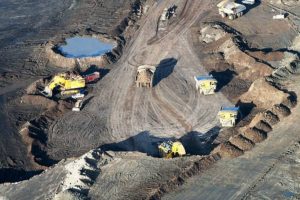
Suncor Millenium tar sands mine on the Athabasca River. Photo credit: David Dodge, Pembina Institute
Given this reality, we must talk about restoring the damage lands. As has always been the case, there will be people who decry such research, saying it only gives the oil companies further justification for their operations. While there’s some truth to this, the reality is that ecological restoration does little to ameliorate climate change in the short run, so as long as the discussion continues to focus on the climate, it’s a non-issue.
There’s also a preventive side to restoration: by fully documenting and time and cost needed to undo the damage, we can set realistic restoration bonds for companies to pay prior to extraction, rather than the token bonds (if any) paid today. This will curtail many of the more-marginal projects, at the very least.
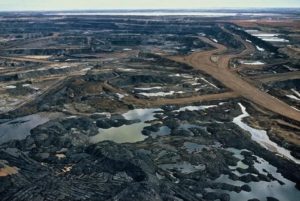
Former wildlife-rich wetlands.
Photo credit: Garth Lenz / Tree Hugger
But when one looks at the situation from the standpoint of the people and wildlife who must live on or near these hideous, toxic landscapes, the argument for ecological restoration becomes crystal clear. We must do it, we must do it now, and we must do it on a grand scale.
Is anyone taking post-extraction restoration seriously? Here’s one company that seems to be: Syncrude Canada Ltd. wanted to create a 57 hectares (141-acre) fen wetland (and surrounding watershed) at its tar sands mine in northern Alberta as part of ongoing mine reclamation activities, and they wanted it to serve as research to improve more such projects.
Reclamation research is integral to Syncrude’s ability to fulfill its commitment to return land disturbed by mining to a productive, biologically self-sustaining ecosystem. In 2008, Syncrude launched the Sandhill Fen Watershed Research Project to learn how to design and incorporate peat-forming wetlands into operational scale reclamation.
The Sandhill Fen is the largest reclaimed wetland in the tar sands and the first ever landform constructed on a foundation of tar sands tailings. The project brought together experts from eight universities to achieve results that are holistic and applicable in the entire context of landscape development and function. After three growing seasons, the Sandhill Fen Watershed is thriving, attracting wildlife and providing valuable information for the future.
A fen is a wetland that accumulates peat. It has a water table about 20cm below ground most of the year and supports a wide range of plants and animals. As such, it is an integral part of the boreal forest and a desired type of ecosystem common in the tar sands region.
Outside of the UK, there is little precedence anywhere in the world for restoration of a fen wetland, much less at the large scale being attempted in Alberta as part of tar sands mine reclamation.
As the lead designer for the project, BGC Engineering, Inc. worked with oil company Syncrude and a team of two dozen researchers to select a target site for such restoration research. They chose a recently sand-capped soft tailings deposit at Syncrude’s Mildred Lake Operation, and proceeded to design and construct a 50-hectare watershed that includes a 15 hectare fen and two additional perched fens.
The watershed and the fen were completed on schedule and are now being presented as a world-class instrumented watershed for reclamation research.
Initial results are encouraging, with the uplands feeding groundwater and surface water to the wetlands. Researchers are testing various reclamation strategies and conducting water and carbon balances.
The site both demonstrates Syncrude’s ability to reclaim these kinds of wetlands, but also provides an outdoor laboratory for learning for the industry and elsewhere how to create watersheds and wetlands. Insights gathered to date were central to the success of the CEMA Guidelines for Wetlands Establishment on Reclaimed Oil Sands Leases (Third Edition, 2014), which BGC played a key role in writing.
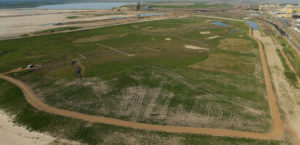
Fen restoration site in 2013, after over 7 million tree and shrub seedlings had been planted since the ’80s. Photo credit: Syncrude Canada Ltd
In June of 2015, the Alberta Emerald Foundation named Syncrude’s Sandhill Fen as the winner of the 2015 Emerald Award for Large Businesses. The Emerald Awards recognize outstanding environmental initiatives in Alberta by individuals, not-for-profit associations, community groups, governments, small businesses and large companies every year since 1992.
“This award recognizes the efforts of many Syncrude employees from across the company, who worked together to create a project that will help guide our efforts with wetlands reclamation,” said Glen Rovang, Syncrude’s Research and Development Manager. “The project has already yielded some encouraging results that will prove invaluable in improving wetland reclamation design and practices at Syncrude and the rest of the oil sands industry.”
The 17-hectare project is part of a research watershed that covers 57 hectares of sand-capped composite tailings in its former 60-metre-deep East Mine. Scientists introduced a variety of wetland plants throughout the fen and planted more than 100,000 trees and shrubs on the uplands surrounding the project. Many other species of trees, willows and shrubs are growing in the watershed on their own without being planted, sprouting from the seed bank in the soil that was salvaged and used in the project.
Syncrude began research on creating fens in 2008 with a field program at our Mildred Lake site that contained 28 experimental plots. Syncrude completed construction of the watershed in 2012 and will closely monitor its progress over the next 10 to 20 years. Syncrude is working with seven universities on different research projects in the fen to study water, wetland and upland plants, the weather and the soil.
The Mining Association of Canada named the project as the winner of the inaugural Towards Sustainable Mining Award for Environmental Excellence in 2014.
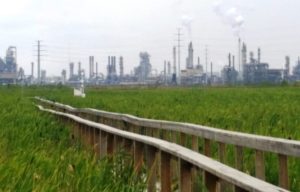
The fen in August of 2017.
Photo by Jaryn Vecchio via CruzRadio.
But scientists who study Canada’s wetland say it might be too early to celebrate. Lee Foote, who once worked on the Sandhill Fen project, commended the company’s efforts, but said he doubts Syncrude will ever return portions of its lease into a pristine fen. “It’s not a matter of whether you can snap your fingers and go straight to a complete and intact wetland,” said Foote, a professor of wetland ecology and management at the University of Alberta. “The bigger question is, can we go to a surrogate functional wetland that’s far better than bare sand, rock and water?”
The fen reclamation project already boasts a return of wildlife, including some endangered species. They include bears, ducks, and many other species of birds. When the restoration is complete, Syncrude intends for the landscape to display the same ratio of wetlands to uplands as was there before the mining operation.
Syncrude ‘s official restoration policy is stated thusly: “Syncrude will ensure the land disturbed by our operation is returned to a stable, safe condition that is capable of supporting biologically self-sustaining communities of plants and animals. Our long-term vision is to create a landscape that sustains an integrated mosaic of land uses that meet stakeholder expectations.”
Let’s hope they, and other fossil fuel companies worldwide, take such commitments very, very seriously. But the truth is, no matter how sincere their commitment—and no matter how much ecological restoration expertise they develop—it will all be for naught if humankind doesn’t drastically curtail the use of fossil fuels. Otherwise, these restored ecosystems will have to fight to survive in a very different climate than the one they were designed for.
Featured photo of Syncrude site by Garth Lenz via Fragile and Wild.
See August 17, 2017 CBC article by David Thurton.
See September 29, 2017 Calgary Hearld article by Gordon Kent.
See Inside Climate News article.
See Union of Concerned Scientists page on tar sands.

